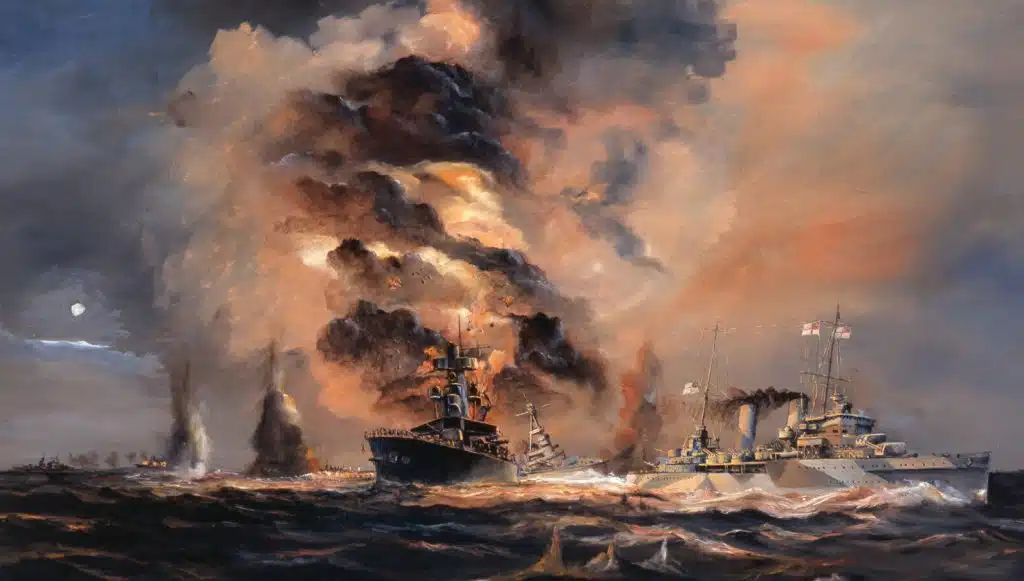Synopsis:
By late 1941 with its oil reserves down to about six months and the US oil- embargo in place in December of that year, Imperial Japan urgently needed oil. To this end, they were already committed to developing a southern strategy in order to seize and occupy the Dutch East Indies to gain access to their vast oil supplies.
In addition, they would also capture British Malaya for their rubber and tin.
Background:
In early 1942, with the Imperial Japanese Navy rapidly advancing south, the Allies attempted to mount a defence of Java in an effort to hold the Malay Barrier.

Established in mid-January 1942, a unified command known as American-British-Dutch-Australian (ABDA Command) was established however even with the best intentions, it proved to be a disaster!
Allied naval units were divided between bases at Batavia in the west, and Surabaya in the east and they were overseen by Dutch Vice Admiral Conrad Helfrich. Due to the ‘spread’ of the conflicts throughout SE-Asia and the Pacific at this time, Admiral Helfrich’s forces were limited, as well as many of his ships being old and some of them so old, they had passed their ’use by date’.
Notwithstanding, Imperial Japan had assembled two major invasion fleets.
Japanese Sighted:
Sailing from Jolo in the Philippines, the Japanese Eastern Invasion Fleet was spotted by ABDA aircraft on February 25. This led Admiral Helfrich to reinforce his deputy and fleet commander – Rear Admiral Karel Doorman’s Eastern Strike Force at Surabaya the next day, with several ships from the Royal Navy.
Departing Surabaya that evening, Doorman’s force consisted of two heavy cruisers, the USS Houston and HMS Exeter, three light cruisers HNLMS De Ruyter, HNLMS Java, and HMAS Perth, as well as three British, two Dutch, and four American Destroyers – making a total of 14 ships.
Sweeping the north coast of Java and Madura, Doorman’s ships failed to locate the Japanese and turned for Surabaya to refuel.
A short distance to the north, the eastern Japanese invasion force, protected by two heavy cruisers Nachi and Haguro, two light cruisers Naka and Jintsu, and 14 destroyers slowly moved towards Surabaya under Rear Admiral Takeo Takagi.
The two Japanese Invasion Forces also consisted of 97 troop transport ships and freighters. At 1:57 p.m. on February 27, a Dutch scout plane located the Japanese Fleet approximately 50 miles north of the port. Receiving this report, the Dutch Admiral, whose ships were beginning to enter the harbor, reversed course to seek battle.
ABDA Commander
- Rear Admiral Karel Doorman
- Two heavy cruisers
- Three light cruisers
- Nine destroyers
Imperial Japanese Navy Commanders
- Rear Admiral Takeo Takagi
- Rear Admiral Shoji Nishimura
- Two heavy cruisers
- Two light cruisers
- 14 Destroyers
The Battle Begins:
Sailing north, Admiral Doorman’s crews prepared to meet the enemy. Flying his flag in the De Ruyter, Doorman deployed his ships in three columns with his destroyers flanking the cruisers.
At 3:30 p.m., a Japanese air-raid forced the ABDA fleet to disperse. Around 4 p.m., Jintsu spotted the re-formed ABDA ships to the south. Turning with four destroyers to engage, Jintsu‘s column opened the battle at 4:16 p.m. as the Japanese heavy cruisers and additional destroyers came up in support.
As both sides exchanged fire, Rear Admiral Shoji Nishimura’s Destroyer Division 4 closed and launched a torpedo attack.
Around 5 p.m., Allied aircraft struck the Japanese transports but scored no hits. At the same time, IJN Admiral Takagi, feeling the battle was drifting too close to the transports, ordered his ships to close with the enemy. Doorman issued a similar order and the range between the fleets narrowed.
As the fighting intensified, Nachi struck HMS Exeter with an eight-inch shell that disabled most of the ship’s boilers and created confusion in the ABDA line. Badly damaged, Doorman ordered Exeter to return to Surabaya with the destroyer HNLMS Witte de With as an escort.
Shortly thereafter, the destroyer HNLMS Kortenaer was sunk by a Japanese Type 93 Long Lance torpedo.
His fleet in disarray, Doorman broke off the battle to reorganize.
Admiral Takagi, believing the battle was won, ordered his transports to turn south towards Surabaya. Around 5:45 p.m., the action was renewed as Doorman’s fleet turned back towards the Japanese. Finding that Takagi was crossing his T, Doorman ordered his destroyers forward to attack the approaching Japanese light cruisers and destroyers. In the resulting action, the destroyer Asagumo was crippled and HMS Electra sank.
Repeated Attacks:
At 5:50, Doorman swung his column around to a southeast heading and ordered the American destroyers to cover his withdrawal. In response to this attack and concerned about mines, Takagi turned his force north shortly before sunset. Unwilling to give in, Doorman steamed away into the darkness before planning another strike on the Japanese. Turning northeast and then northwest, Doorman hoped to swing around Takagi’s ships to reach the transports. Anticipating this, and confirmed by sightings from spotter planes, the Japanese were in position to meet the ABDA ships when they reappeared at 7:20 p.m.
After a brief exchange of fire and torpedoes, the two fleets separated again, with Doorman taking his ships inshore along the Java coast in another attempt to circle around the Japanese. At approximately 9 p.m., the four American destroyers, out of torpedoes and low on fuel, detached and returned to Surabaya.
Over the next hour, Doorman lost his last two destroyers when HMS Jupiter was sunk by a Dutch mine and HMS Encounter was detached to pick up survivors from Kortenaer.
A Final Clash:
Sailing on with his four remaining cruisers, Doorman moved north and was spotted by lookouts aboard Nachi at 11:02 p.m.
As the ships began to exchange fire, Nachi and Haguro fired spreads of torpedoes. One from Haguro fatally struck De Ruyter at 11:32 p.m., exploding one of its magazines and killing Admiral Doorman.
HNLMS Java was hit by one of Nachi‘s torpedoes two minutes later and sank. Obeying Doorman’s final orders, USS Houston and HMAS PERTH fled the scene without stopping to pick up survivors.
Aftermath:
The Battle of the Java Sea was a resounding victory for the Japanese and effectively ended meaningful naval resistance by ABDA forces.
On February 28, Takagi’s invasion force began landing troops 40 miles to the west of Surabaya at Kragan.
In the fighting, Admiral Doorman lost two light cruisers and three destroyers.
One heavy cruiser was badly damaged and around 2,300 sailors were killed.
Japanese losses numbered one destroyer badly damaged and another with moderate damage. Though he was soundly defeated, that the Battle of the Java Sea lasted seven hours is a testament to Doorman’s determination to defend the island at all costs.
Summary:
On the night of February 28, Japanese troops landed on Java and began moving on their objectives. Despite the best efforts of American artillery, British tanks, and Australian and Dutch troops, the defences collapsed.
On March 9, the Dutch East Indies surrendered. The Japanese had expected to conquer the oil- and resource-rich archipelago in six months.
They did it in three.
Many things contributed to the failure of the Allies at the Battle of the Java Sea. Foremost was the inferiority of Allied numbers and power of the Japanese Force. The Japanese vessels were modern, equipped with powerful torpedoes, and had crews well trained in using them. The Allied sailors were long-service veterans, but they had not trained or worked together for any length of time and were operating elderly ships with inefficient weapons. The U S N destroyers dated back to 1916, and their torpedoes did not detonate.
Most importantly, the command structure in the Dutch East Indies was the first such attempt by the Allies to create a unified multinational force. It lacked unity, cohesion, common communications procedures, and clear chains of command and authority.
Later in the war, when multinational Allied forces invaded Sicily, Italy, France, Burma, and Germany, the command procedures were more authoritative, and clear, weaponry and communications unified, tactics simplified. The multinational Allied Fleet that returned to Java to bombard and shell Japanese installations and oil fields in 1944 would bear little resemblance to the Fleet that went down at the Java Sea beyond the national flags that flew over the attacking warships.




